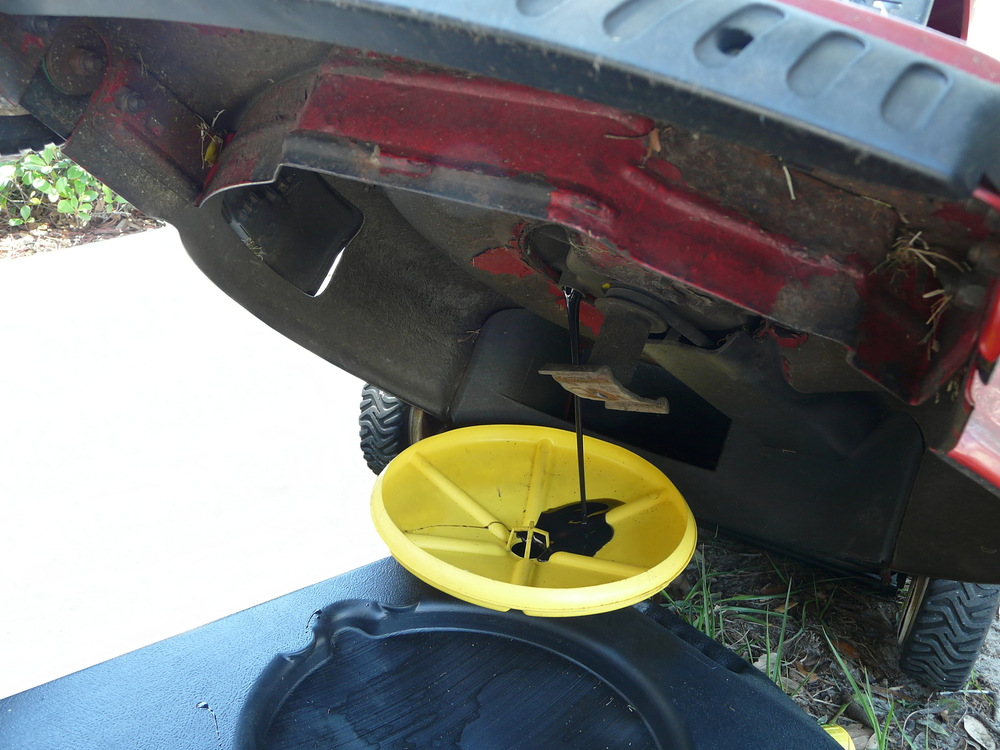Learning how to replace lawn mower oil is one of the best ways to help maintain and prolong your equipment’s life. Oil lubricates the internal components of your lawn mower, reducing friction while helping maintain the correct operating temperature so that it operates efficiently. So, this is how to replace your lawn mower oil for optimal performance.
To replace the oil in a push lawn mower, remove the oil cap and dipstick. Insert a hose into the oil filler tube or place the lawn mower on its side to pour the oil out. Replace the oil with a straight 30W detergent oil or as your guide recommends. Test your lawn mower to make sure it runs properly.
In this content you’ll learn:
My Experience With Replacing Lawn Mower Oil
From my early years working with all sorts of farming equipment, I’ve always loved taking small engines apart to see how they worked and why. One of my biggest surprises was when I saw just how much damage you can do to an engine by not changing the oil regularly.
One of the staff on the farm had run a lawn mower without sufficient oil. It wasn’t long before the engine stalled in the hot summer temperatures. He brought in an engine that wouldn’t even turn over, let alone start.
On taking the engine apart, the piston had seized inside the bore, and evidence of melted metal and pieces of the internal components lay inside the crankcase. I still, to this day, cannot understand how he didn’t feel the heat of the melting engine or why he ignored the belching smoke.
Needless to say, the lawn mower was a complete write-off, and we made sure he always checked the oil level before using any piece of equipment.
I’ve always made a point over the last 25 years to ensure to change the oil at least annually on every lawn mower I’ve owned. I also keep a careful note of how many hours each machine is in use so that the oil is changed after a maximum of 50 hours.
Through this maintenance schedule, I’ve yet to lose another lawn mower through negligence.
Understanding Lawn Mower Oil And Why It’s Essential To Replace It

You should not use oil designed for your motor vehicle to replace lawn mower oil. Lawn mowers require oil specifically designed for use in their engines.
I’ve found that most of my outdoor equipment does well on either 5W30 synthetic oil or 15W30 oil. Colder climates call for a slightly less viscous 5W oil, while hotter climates require 15W oil to provide the necessary protection.
In my experience, whether you use conventional, synthetic oil, or synthetic blends, so long as you use the right weight, your lawn mower will run perfectly well. The “weight” of an oil is an indicator of its viscosity or its resistance to flow. The higher the viscosity (weight), the less inclined it is to flow.
Getting the oil to flow requires heat, which is why higher-weight oils are used in hotter climates or conditions, and lower-weight oils are recommended for colder climates.
The higher-weight oils need more heat to flow smoothly throughout the engine, so they are better suited to hot climates or prolonged use. The smoothly flowing oil helps to protect the engine components and dissipate the heat.
Oil Options
Look for oil with the following specifications:
- Warmer temperatures – SAE 30
- Colder climates – SAE 10W-30
- All conditions – Synthetic SAE 5W-30
- Freezing climates – SAE 5W-30
- Commercial Usage (extended mowing times) – 15W-50
Synthetic oils protect your lawn mower from a broad range of temperatures. I’ve found I use less oil when running with synthetics, and both cold and hot starting improve.
When the engine is cold, the synthetic oils tend to circulate better before they reach the optimum operating temperature. With hot starting, after refueling, for instance, the synthetic oils tend to stay on the component surfaces rather than flowing down into the bottom of the engine. This provides critical lubrication when the engine is hot and needs oil on the contact surfaces to prevent premature wear.
Avoid using any special additives, as they most likely cause more harm to your lawn mower engine than good.
Detergent Oils
Improvements in oil technology have given us detergent oils that contain various additives that help prolong the oil’s useful life by preventing rust and helping to stabilize acids. The detergent oil is also designed to break down the sludge that collects in the engine over time.
Choose a detergent oil with the following classifications based on the manufacturing year:
- SG (only for engines built before 1993)
- SH (only for engines built before 1996)
- SJ (for engines built from 2001 onward)
- SL (for engines built from 2004 onward)
The “S” is an American Petroleum Institute (API) designator, meaning the oil suits gasoline engines. Don’t use oil with a “C,” as it is designed for diesel engines.
Old Oil
Older oils have become obsolete as they don’t offer the necessary sludge protection required in more modern engines. If the oil fails to keep the damaging particles in suspension, your lawn mower will wear out much more quickly.
The oil in your lawn mower is designed to provide lubrication and distribute heat evenly. As the oil ages, it loses its ability to lubricate efficiently. This causes increased heat leading to wear and tear on the engine components. For this reason, it is essential to change your oil at least every year or after 50 hours of use, whichever comes first.
When you change your engine oil, any small pieces of metal or other muck that gets into the oil are also removed. This helps to reduce engine wear and tear further.
How To Replace Lawn Mower Oil

Changing the oil in your lawn mower can be smooth if you prepare it correctly.
Here’s what to do.
1 – Gather Needed Tools
Place the lawn mower on a flat surface in your workshop, using chocks to stop it from rolling forwards or backward if necessary. Always work in a well-ventilated space, just to be safe.
Here’s what you need to perform an oil change:
- An oil drain pan (for collecting oil)
- Cleaning cloth (for mopping up spills)
- Wheel chocks
- Strap or filter wrench
- Grease or Vaseline
- Socket wrench set (to remove oil drain plug in larger self-propelled and ride-on lawn mowers – most push mowers only require you to remove the dipstick to pour the oil out)
- Sandwich bag (to put over the fuel filter opening)
- A funnel
- An oil filter (most ride-on mowers require this – check your lawn mower manual for further information)
- Oil (check your manual for recommended kinds)
- A pair of pliers (to remove the spark plug lead if you can’t pull it off with your fingers)
2 – Take Proper Safety Precautions
Here’s what gear you need to stay safe:
- Safety goggles
- Work gloves (I’ve not used gloves for most of my life working on engines, and the corrosive properties of fuel and oil have damaged the skin on my hands quite badly)
Before changing the oil, it helps if you run the lawn mower for a few minutes to heat it so it flows more easily. This also ensures that any sludge at the bottom of the engine will then circulate with the oil and become suspended in the oil.
Avoid touching the exhaust and disconnect the spark plug lead before working on the lawn mower.
Prevent fuel from entering the air filter by tipping the lawn mower to the opposite side of the filter.
Grab a sandwich bag to put over the fuel filler pipe. This will prevent the fuel from spilling out when you tip your lawn mower on its side. When used during operation, the fuel cap is vented to let the pressure equalize inside the fuel tank. Screwing the cap over the plastic closes off the top of the fuel fill pipe, preventing the fuel from dripping out of the cap (just remember to remove it before starting your lawn mower).
3 – Drain The Old Oil
Draining the oil is a straightforward process that shouldn’t take you more than 20 – 30 minutes.
1 – Locate The Oil Drain Plug
After the lawn mower has a little, locate the oil drain plug. If you can’t find one, tip your lawn mower on its side to allow the oil to run out of the oil filler tube.
You can find the oil drain plug under the cutting deck (the part of the lawn mower that protects the user and lawn mower engine from the lawn mower’s blades and debris). Grass and muck will typically cover the oil drain plug. Clean off the plug with a rag so no muck enters the engine.
Ride-on lawn mowers usually have their drain plugs toward the back of the deck. If you can’t locate it, you can always use an oil siphon to suck the oil out of the engine through the filler tube.
The filler tube is normally capped with a yellow or grey/white screw top attached to the oil dipstick. Unscrew the cap and remove it to access the filler tube.
2 – Drain Oil
Position the lawn mower over the oil drain pan and use the socket wrench to turn the oil drain plug bolt counterclockwise.
Once it’s loose, wait for the oil to drain out before replacing the drain plug. If you can’t locate the drain plug, use the old-fashioned method. Tilt the lawn mower on its side and allow the oil to drain through the filler pipe after removing the dipstick.
What To Do For Ride-On Lawn Mowers
You’ll find a drain hose on ride-on lawn mowers with a locking mechanism on the end sticking out of the side of the engine. On older models, it’s usually a short black tube sticking out horizontally. Newer models have longer black tubes with a bright yellow or orange cap on top.
Twist the locking cap until it disengages the locking pin, and pull the cap off. Make sure you have the drain pan underneath to catch the oil. Let the oil drain, and then replace the cap.
To dispose of your oil, pour it into a container with a cap, and take it to your local auto parts store or mechanic.
4 – Changing The Oil Filter
Many lawn mowers do not come with an oil filter. But if yours does, then here’s how you replace it.
Oil filters come in two types, a cartridge style or a spin-on style. The cartridge style only requires you to replace the cartridge inside the housing, while you replace the spin-on style in its entirety.
For ride-on-lawn mowers, pop the engine cover up and look for a black cylinder-shaped object usually located right beneath the oil drain pipe. To remove the oil filter, you need a strap wrench or filter wrench to unthread the filter.
Just remember the oil filter will have some oil in it, which will spill out once it comes loose.
Most ride-on lawn mowers have spin-on style oil filters. Once you unscrew the oil filter, replace it with a new one by threading it back on and then tightening it by hand.
Add oil or grease and rub it around the filter gasket to get a good seal on the new oil filter. The gasket is the black rubber ring that seals the oil filter when installed on the engine.
This will ensure the oil filter will not leak once you replace it.
I’ve found that Vaseline also works well if you don’t have any grease handy.
Most push lawn mowers don’t have an oil filter, but check your manual to make sure.
5 – Add Fresh Oil
Once you’ve drained the old engine oil, ensure you’ve screwed the drain nut tight and that the filter is in place.
Fill the engine with oil based on the manufacturer’s instructions in your manual. If in doubt, follow our suggested oil selection criteria above.
If you have a narrow oil filler tube, insert the funnel so you don’t spill oil as you pour. For push lawn mowers, pour half the contents of the oil bottle and then insert the dipstick.
Check the oil level on the dipstick before adding a little more. Take your time and ensure you don’t fill the engine with too much oil. The correct oil level is marked on the dipstick with either the word “MAX,” or there’s a line with cross-hatching underneath.
To correctly check the oil, ensure the lawn mower is on a level surface, clean off the dipstick, and insert it into the engine. Pull it out and check it to see at what level the oil is showing on the oil level gauge.
Keep adding a little oil at a time, constantly checking to see that the oil level does not rise above the MAX line.
5 – Perform A Post-Oil-Change Check
After completing the oil change, check that the oil level is correct before starting the lawn mower. You will find that the oil level will drop after you start the lawn mower if there is an oil filter.
Some of the oil will stay behind in the filter, and you must add more oil to raise the level again.
When you’ve changed the oil, you should also check whether the air filter is still in good condition or needs replacement. You may also have to change the spark plug if it is badly worn.
You’ve completed the oil change once you have determined that the oil level on the dipstick is correct (not above MAX) and the engine is running smoothly with no sign of white or black smoke coming from the exhaust.
Allow the lawn mower to run for three or four minutes after the oil change so that it reaches operating temperature and you can complete your checks.
How Often Should You Change Lawn Mower Oil?
By replacing your oil at least once a year before mowing season, you’ll ensure your lawn mower will give you improved performance and extend its engine life.
Final Advice
Always change your oil. It’s better to prevent issues than to react to them, and by consistently checking and changing your oil, you’ll avoid a hard lesson like I and many others have learned.

